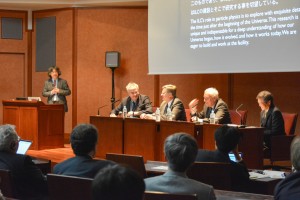Last week during the Asian Regional Workshop ALCW 2015 held in Tsukuba, the ILC broke with the tradition of staying in one place when the workshop participants moved en masse to Tokyo for what is best described as a multicultural extravaganza in support of the International Linear Collider. Taking advantage of the workshop’s location in Japan the organisers arranged a special “Tokyo Event”, to highlight the benefits of the ILC to Japanese society. The first part of the event was open to all members of the public who pre-registered but was targeted at politicians, industrialists and media. The gathering was very well received with more than 400 attendees. There were two parts to the event; in the afternoon there was a symposium held at the University of Tokyo’s Ito Hall lecture complex, in the evening the spotlight moved to a special banquet at the Hotel New Otani. In between these two activities the LCC management managed to squeeze in a short meeting with the Federation of Diet Members to promote the realisation of the ILC, which some 160 Japanese diet members (about quarter of all diet members) have joined.
The Symposium was started by Lyn Evans who thanked the University for the welcome shown to the project and introduced the audience to the Tokyo Statement from the Linear Collider Collaboration stressing the technical readiness and scientific validity of the ILC. Lyn was followed by a short welcome from Ryu Shionoya, a Diet Member from the House of Representatives and Secretary-General of the Diet Members Federation, who welcomed the Workshop delegates. The keynote address was then given by Hiroya Masuda, Chairman of the Japanese Policy Council. He described the potential demographic challenge facing Japan due to population decline over the next several decades. He then discussed how projects such as the ILC could play a role in stemming this reduction and could be especially effective in regional rejuvenation. Mr. Masuda’s thought-provoking presentation was then followed by a panel discussion. Moderated by Hitoshi Murayama, deputy Director of LCC, the panel consisted of Joachim Mnich (DESY, Germany), Jonathon Bagger (TRIUMF, Canada), Hiroaki Aihara (University of Tokyo, Japan) and Lyn Evans and they gamely addressed a wide variety of topics provided by Hitoshi. There was, of course, general agreement with Jonathon’s observation that the precision of the ILC was “made for the Higgs” with clean collisions and complementary physics to the proton colliders. Joachim noted that the large circular lepton machines were coming to the their natural end and future linear colliders would provide the route to higher energies for electrons. Hiroaki pointed out that the ILC is a huge project which must be approached carefully and must maintain balance with other fields of science. He mentioned that High Energy Physics field can sometimes come across as arrogant (who, us??) and this is not conducive to inter-disciplinary harmony. He also added that there is little Japanese experience in international leadership in international projects, thus external political help will be crucial. Lyn returned to Mr. Masuda’s demographic possibilities for the ILC by noting that the LHC programme has stimulated significant renewed interest in science within the EU and saw no reason why the ILC should not fulfill the same role in Japan. The symposium ended with a short message from the Masanori Yamauchi, the incoming KEK Director General, on future plans, and a symposium summary from Hitoshi Murayama which, as usual, was presented so enthusiastically that it reduced the translator to sporadic interjections of translated speech fragments.
The delegates then moved on to the special banquet portion of the evening dubbed the “Taste of Discovery”. The HEP community is by its nature very cosmopolitan. When the banquet organisers indicated that, stressing the international nature of the ILC, the gustatory theme for the evening would be provided by asking the diplomatic embassies for the menu of a signature dish from those countries represented in the ILC Technical Design Report, I suspected the logistics involved would prove a real challenge for any hotel. It was therefore exciting to see a veritable cornucopia of international food awaiting everyone when the banquet started. I did not try to count the different offerings but it certainly seemed consistent with the TDR authors’ list of home countries (48). An unscientific sampling of the crowd confirmed the excellent quality of the food too (as did the speed of consumption). In addition to the food offering, Japanese culture was also highlighted throughout the proceedings. A Taiko demonstration (synchronised Japanese drumming) by a performance group named “indra” was part of the entertainment as well as a calligraphy performance by Tomoko Kawao. She is .one of the most high-profile calligraphy artists of Japan. Dipping an enormous brush into a well of ink, she wrote a dramatic rendition of four Chinese characters, “宇宙創成” (meaning “creation of the universe) on a big sheet of paper. In a smaller setting demonstrations of traditional Japanese water colour painting were on hand as well as traditional tea ceremony participation. I can personally attest to some very interesting green tea. The crowd consisting of a mixture of embassy staff, political and industrial supporters, were highly appreciative of the time and effort which went into both the food and the entertainment.
Too soon the time passed and it was time to return to Tsukuba in preparation to resume the workshop activities the following day. Those present will certainly cherish the memories of their trip to Tokyo this year.



Recent Comments